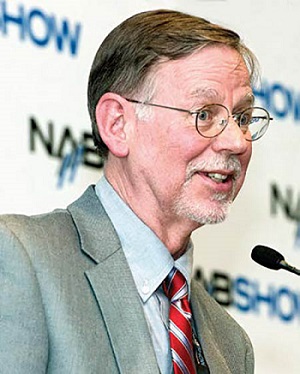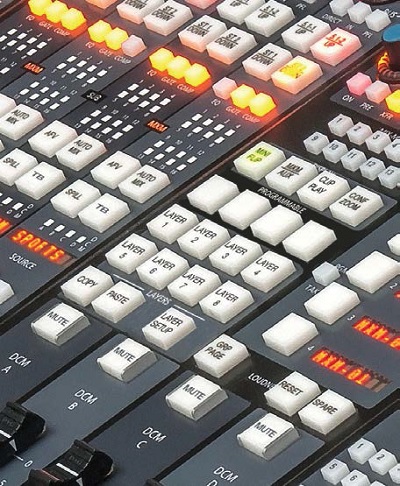AES67 ‘Another Arrow in the Quiver’
LOS ANGELES—As computer scientist Andrew Tanenbaum famously observed in the mid-1990s, “The nice thing about standards is that you have so many to choose from.” Fast forward two decades and the audio industry is poised to implement a new standard, AES67, which is intended to allow the exchange of data between disparate IP audio networks.
The AES established a working group in 2010, designated X-192, after recognizing that various incompatible audio networking schemes were already in existence. The eventual standard, AES67-2013 (published in September 2013), enables interoperable high-performance streaming audio-over-IP, or AoIP.

Phil OwensECONOMY OF SCALE
“Our take on AES67 is that we welcome it; we have made it so that our system is compatible with it,” said Phil Owens, head of Eastern U.S. Sales for Wheatstone in New Bern, N.C. But, he added, “We’re thinking of it as ‘another arrow in the quiver.’”
As Owens noted, there are already numerous ways to get in and out of WheatNet-IP, Wheatstone’s Gigabit Ethernet network, and AES67 can now be added to that list. “A person can put together a Wheatstone network that includes I/O from playout devices equipped with our software drivers as well as analog, AES, MADI, HD-SDI and—now— AES67. It’s equivalent to the blue M&M that everyone is talking about, because it’s new. But if you step back, it’s just another way to get in and out of our system.”
WheatNet-IP, as a layer 2 protocol, takes full advantage of the economy of scale and the resources of the massive IT industry, which means that cost and reliability need not be a barrier to adoption. “Our audio will travel through an off-the-shelf switch that you can buy at Staples,” Owens stressed.
Plus, he noted, IT equipment manufacturers have long since developed mechanisms ensuring mission-critical reliability. “Redundancy is built into your network topology in the way that you connect your switches and the network protocols that you implement. So we’re not only taking advantage of the cost effectiveness of standard space switches, but we’re taking advantage of the IT capability that’s been built up over the years to handle large networks.”
Further, while older audio technologies required special optical network cards to access fiber when distances exceeded the capabilities of Ethernet, now, “Even a smaller Cisco switch has SFPs [small form-factor pluggable] for fiber transceivers. Laying down a switch on each end with fiber between them is child’s play,” said Owens.
Get the TV Tech Newsletter
The professional video industry's #1 source for news, trends and product and tech information. Sign up below.

Wheatstone Dimension Three TV audio consoleCAPACITY ADVANTAGE
AoIP has a significant advantage in capacity over another audio transport standard, AES10 or MADI, which has enjoyed something of a resurgence since its original publication in 1991. “We did a test recently to see how many audio channels we could cram down a Gigabit pipe using our system,” Owens reported. “The number turned out to be 428. You’re moving from 64 channels of MADI to over 400 channels using Gigabit IP audio. That’s quite an increase in possible functionality.”
WheatNet-IP I/O devices are known as BLADEs, continued Owens, and enable various combinations of the supported connections to be introduced to the network. But Wheatstone’s network offers much more than just audio transport.
“In addition to getting I/O capability out of a BLADE you get other functions, like background mixing, audio processing, silent sensing and signal processing, the ability to do automated switching based on the status of a certain cross-point or based on silence detection,” he elaborated. “It gives you a Swiss Army knife of tools that you can use. You not only get a distributed audio network where you can deploy these BLADEs wherever audio is needed, but you get a whole toolkit of functions that are very handy in the audio environment.”
That list of functions is very appealing to engineers, whether in television or radio, according to Owens. “We probably have 50 TV stations that are running BLADEs,” he said. “The reason is that they like that list, and the ability to plop a BLADE down in their newsroom and be able to send audio out to it and get audio from it.
“There are two major TV groups in the country that between them probably own more stations than anyone else that have standardized on IP and our BLADE system. They’ve done it for the reasons that I mentioned— they like that distributed control and audio gathering in a system where you can also put a stack of BLADEs in your tech center and have the equivalent of a large mainframe router.”
THE ‘NETWORK EFFECT’
Perhaps the most important benefit of AES67 will be the “network effect,” otherwise known as Metcalfe’s law. The term, initially applied to the telecommunications industry, recognizes that the value of a network is greater than the sum of its parts once it reaches a critical mass of users.
“There will be peripherals that could add functionality to our system,” Owens acknowledged. “For that reason we feel good about it and that’s why we incorporated it into our latest BLADE release, version 3, which we introduced at the end of last year.”
Yet, as AES67 currently stands, those third-party peripherals can be integrated only so far, since the standard lacks a control protocol, such as that incorporated into WheatNet-IP. “[AES67] is not going to come into its own until the control part gets added,” said Owens. To that end, an AES working group, X-210, was formed in late 2012 to develop a standardized protocol based on Open Control Architecture, the open standard communications protocol.
Ultimately, AES67 offers an insurance policy, said Owens, but it’s no substitute for a comprehensive system such as WheatNet-IP. “People will feel better about implementing a system that they know conforms to standards,” he said. “But it will never be the be-all and end-all of audio connections for the main audio gear, because that’s what we’ve all worked so hard on when we created our individual systems. Wheatstone has a top to bottom integrated system that includes consoles, routers, and peripherals that interoperate seamlessly over IP, but we can also envision a day when we will use a truly boundaryless network of things. AES67 is a move in that direction.”
Steve Harvey began writing for Pro Sound News and Surround Professional in 2000 and is currently senior content producer for Mix and a contributor to TV Tech. He has worked in the pro audio industry—as a touring musician, in live production, installed sound, and equipment sales and marketing—since November 1980.
